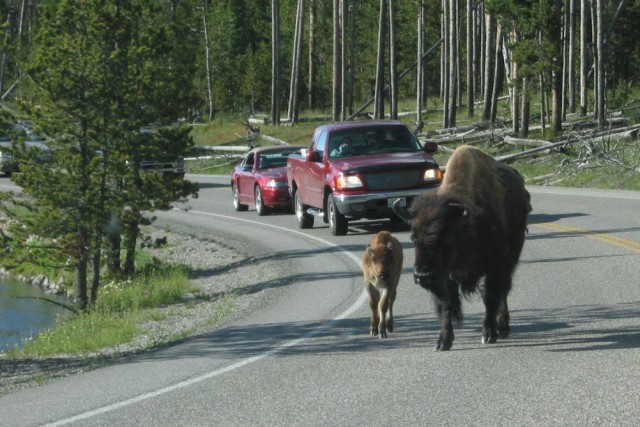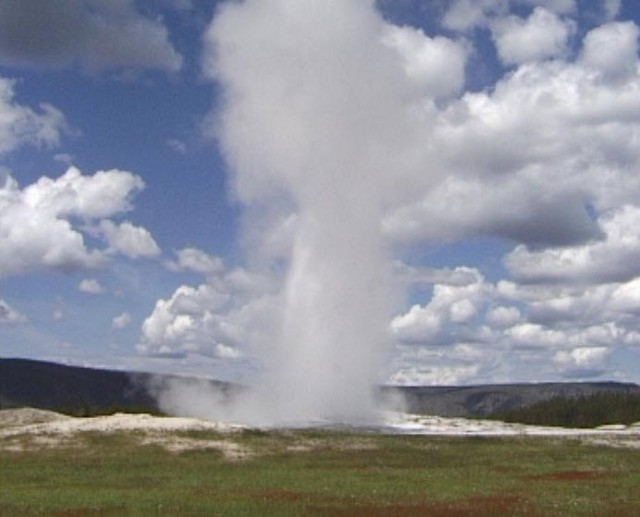
President Obama signed a law last Monday making the bison, tens of millions of which once roamed North America, the country’s first national mammal. The designation does nothing to threaten the bald eagle’s position as the national animal because (of course) a bird is not a mammal. A great place to see free-ranging bison is Yellowstone National Park. Wikimedia commons photo.
13 May 2016 – Happy 100th Birthday, National Park Service
Some called it “America’s Best Idea.”
I am inclined to agree. The idea was the concept of NATIONAL PARKS!
In 1872, the Yellowstone National Park Act created the world’s first national park. Yellowstone is a 2.5 million acre park situated on Yellowstone Plateau in Wyoming. Directly beneath the plateau is a vast volcanic hot spot. Geologists have found evidence of three giant calderas, the results of three stupendous explosions over the past two million years. The Yellowstone hot spot is known as a supervolcano, a place where volcanic activity powers right through a tectonic plate (instead of just along the edges of those plates.) And it is truly spectacular.
National Geographic magazine refers to Yellowstone as a “gigantic pressure cooker fueled by one of the most massive supervolcanoes on Earth. Water from rain and snowmelt, much of it centuries old, percolates down through cracks in the Earth’s crust. The water is heated by magma reservoirs to well over the surface boiling point, but remains in a liquid state because of the pressure of overlying rock and colder water. The superheated water filters upward, eventually finding release in the thousands of geysers, hot springs, and other hydrothermal wonders that have awed visitors since the first expeditions to Yellowstone in the late 19th century.”
During 1869 through 1871, three different expeditions were mounted to the area. The men exploring the Yellowstone Plateau were mightily impressed with the scenery and its possibilities, particularly as a resort area. The thought of the revenue generated by getting tourists into Yellowstone no doubt encouraged the backers to push for the protection of the area as a park. Congress embraced this plan, and on March 1, 1872, President Ulysses S. Grant signed the bill creating “a public park or pleasuring-ground for the benefit and enjoyment of the people.”

Old Faithful is a cone geyser located in Yellowstone National Park. It was named in 1870 during the Washburn-Langford-Doane Expedition and was the first geyser in the park to receive a name. Wikimedia commons photo.
Commercial exploitation of fish and game was prohibited in the park. This was meant to protect the wildlife, but was largely ignored. After all, visitors to the park had to eat, and what was more readily available than elk, bison, and rainbow trout. Also, “market hunters established themselves brazenly in the park” killing game in “industrial quantities.” It took the passage of the Lacey Act of 1894 in order to protect Yellowstone’s wildlife. Still, predators, such as timber wolves and cougars, were ruthlessly persecuted in Yellowstone for decades.
More national parks followed Yellowstone’s success, including Rock Creek in Washington D. C., Yosemite and Sequoia in 1890. In 1916, a law was passed that created the National Park Service to facilitate the management and protection of the parks. The National Park Service’s Mission statement goes as follows:
“The NPS preserves unimpaired the natural and cultural resources and values of the National Park System for the enjoyment, education, and inspiration of this and future generations. The National Park Service cooperates with partners to extend the benefits of natural and cultural resource conservation and outdoor recreation throughout this country and the world.”
The National Park Service now manages over 400 units of natural, cultural, historical and recreational areas in the United States, its territories, and its possessions. Of these some 50 units are designated as National Parks. To be selected as a national park, the area must show natural beauty, unique geological features, unusual ecosystems, and/or recreational opportunities. Historical and cultural units are usually referred to as National Monuments.
In Texas, we have Big Bend National Park, Guadalupe Mountains National Park, the Big Thicket National Preserve, and Padre Island National Seashore. El Camino Real National Historic Trail, the San Antonio Missions, and Fort Davis are all historic sites. An archaeological site, the Alibates Flint Quarries is a National Monument. Our most recent unit in the National Park System is the Waco Mammoth Site which was signed into law by President Obama on July 10, 2015.

If you fancy paddling with a spectacular view, then Santa Elena Canyon at Big Bend National Park may be for you. It’s a popular overnight or three day trip, not only because the put-in and take-out are easily accessed by car, but because it’s often considered the most dramatically beautiful activity in west Texas. Santa Elena has the tallest cliffs forming the canyon wall (up to 1,500 feet). Big Bend is part of our state and should be enjoyed by all. Wikimedia commons photo.
You owe it to yourself and your family to see as many of our national park units as you can. Start close to home with Padre Island or the San Antonio Missions. Then branch out. West Texas’ Big Bend National Park and East Texas’ Big Thicket Preserve are as different as night and day. You really need to experience both of them to appreciate our state’s ecological diversity.
If you can get to Yellowstone, the world’s first national park, you will be especially amazed. In the 1980s a movement was launched to recognize the entire park and surrounding area (over 22 million acres) as a single ecosystem. The Greater Yellowstone Ecosystem is a complex mosaic of public and private land that is being managed partially by the National Park Service, the U.S. Forest Service, and private landowners. This partnership is the key to the sustainability of plant and animal life in the ecosystem.
Managing the world’s wild places as ecosystems is our best chance to save the world and all the beauties of nature. Support National Parks!
If you would like to offer comments, please click through to the discussion page
